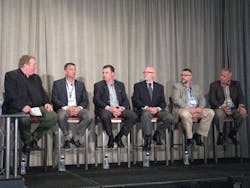CHICAGO – “Is this the new normal?” Russell Thrall III, Editor in Chief of CollisionWeek, posed that question to panelists of the “Advanced Vehicle Technology Ensures that Pre- and Post-Scanning is Here to Stay!” portion of the Advanced Technology & Diagnostic Repair Forum today at Hyatt Regency McCormick Place.
While all of the panelists answered with a conclusive “yes” — incorporating pre- and post-scanning into the repair process is necessary and thus the new normal — some had variations on that theme.
Chris Evans, Claim Consultant P&C Claims, State Farm Insurance noted, “This is a trend that is not going to turn around. Consumers are buying vehicles more for their convenience systems than for anything else. The need for scanning is not going away at all.”
From left to right: Moderator Russell Thrall III, Editor in Chief, CollisionWeek; Vincent Claudio, Senior Vice President, Gerber Collision & Glass; Chris Evans, Claim Consultant P&C Claims, State Farm Insurance Companies; Darrell Amberson, President LaMettry’s Collision; Matt DeWalt, Co-owner, Legacy Autobody Group; Mark Woirol, Senior Manager, Allstate/Tech-Cor.
Darrell Amberson, President of LaMettry’s Collision, had a slightly different take, explaining that the collision repair industry has not yet transitioned enough for pre- and post-scanning to be considered “normal.” He expressed, “It is becoming the norm; It tends to take—too often—years for the industry to fully acclimate to new processes. We have more work to do.”
Mark Woirol, Senior Manager, Allstate/Tech-Cor, looked further into the future. “I don’t think it’s the norm. I think it’s a new beginning. The issues we face with pre- and post-repair scanning are just the beginning of things to come as vehicle technology becomes more advanced. It’s going to be a new generation of how we fix cars. Not long from now, sixty percent of what collision repairers do to repair vehicles is not going to be body and paint work,” he noted.
The conversation, moderated by Thrall, covered two of the major issues the collision industry is facing in regards to scanning: access to OEM repair information and training.
Matt Dewalt, Co-owner, Legacy Autobody Group, discussed his business’s approach to training for scanning. “We use I-CAR as a foundation for our training. From there we rely on the OE information. It’s a challenge because the industry is lacking a unified system to look up OE information. It’s as if we need training just on how to go about finding and accessing the information we need,” he explained.
Adding to the issue of access, Evans addressed the need for more detail in the language of scanning requirements. He noted, “We don’t need more information, but better information. We need more specificity and detailed information with OEM position statements. I’ve made it a point to distinguish between a position statement that is generally broad and a detailed technical repair procedure. I can see that improving over time. I know OEMs are working towards that, but we’re not there yet, and the gap between those two references is often the root of friction that we’re experiencing in the industry today.”
“From a training perspective, the biggest challenge we have is knowing the calibration steps that are necessary,” Woirol added. Woirol also explained that it’s not just about having the proper information from each OEM, but that OEMs use different terms for the same type of procedure. “We need consistent conversation and terms from OEMs about what the requirements are. This is just like the issue with categorizing high-strength steel—everyone has a different definition for it.”
In discussing the issues this new norm of scanning presents, all of the panelists expressed hope that the industry will adapt and that it is actively working to find solutions. While daunting, DeWalt summed up the challenge simply: “Technology has grown exponentially—we just have to grow exponentially with it.”


